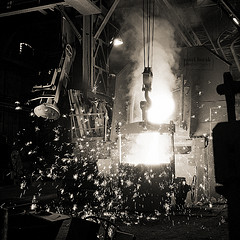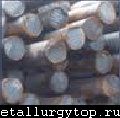Many Terms To Know For A Weapon
 Blade construction varied over the years based on the material and technology used. In the early years of metallurgy, blades were short. The length was limited by the material used until such time as smithing technologies improved to increase the tensile strength of the material. Bronze was first turned into blades due to the lower smelting temperature and produced a better blade. Iron was next, which although softer, had ore material that was more readily available and therefore used to outfit entire armies.
Blade construction varied over the years based on the material and technology used. In the early years of metallurgy, blades were short. The length was limited by the material used until such time as smithing technologies improved to increase the tensile strength of the material. Bronze was first turned into blades due to the lower smelting temperature and produced a better blade. Iron was next, which although softer, had ore material that was more readily available and therefore used to outfit entire armies.
Later the construction of the blade was altered yet further by introducing 'fullers'. The 'fuller' was a ridge that ran down the center of the blade. This left a groove like structure that eliminated metal material and therefore made the blade lighter, but was able to maintain its' strength, much like a steel I–beam used in construction.
The 'ricasso' was a short area of the blade immediately above the hilt on the blade side of the 'cross guard' which was not sharpened at all. This area was gripped by the finger for better tip control. Some blades did not have the 'ricasso'. In some other instances however, the 'ricasso' was large enough for a hand to fit around it and was therefore wrapped in leather. The purpose was to allow the other hand to be used to better manipulate the blade, especially dealing with large swords such as the enormous German Zweihänder.
The 'tang' is the part of the blade that extends into the hilt under the grip. This is also the part of the blade to mark the manufacturers' information. The 'tang' can be created as part of the blade, referred to as a 'full' tang. A 'full–tang' is preferable and was normally how blades were created anciently. This style of tang was necessary for durability in battle.
In some modern instances, to minimize manufacturing time and create a blade for display rather than actual use or authentic creation, a separate rod of steel or iron is welded to the blade and then the hilt is formed or fitted around it. This type of tang is referred to as the 'rat tailed' tang. This type of tang is structurally weaker and will most likely break off at the welding point if the Sword were to be put into action.
The curvature of the blade maintained an important feature of the sword. The curved radius of the blade was purposed to create a sawing effect on the battlefield, rather than simply delivering a heavy cut. By employing this feature the efficiency of the blade was improved and thereby reduced the amount of effort required to do the needed damage.
The curvature radius was altered and based on the country of origin. The middle eastern regions had a curvatures of radius closer to the hilt than those of their European counterparts, which accommodated the different battle techniques. The radius curvature was designed to be effective at the length that the warrior would use the weapon. So a longer curvature further away from the wielder, would be intended to be used at a longer distance.





Rio Tinto готовится сорвать «сделку века»
 Первая и третья в списке горнодобывающих компаний мира, BHP Billiton Ltd. и Rio Tinto Group, могут так и не объединить свой горнорудный бизнес на территории Австралии в актив стоимостью 120 млрд долларов. Рекордная в истории Австралии сделка будет сорвана по инициативе руководства Rio Tinto, пишет местная газета Sidney Morning Herald со ссылкой на анонимные источники, близкие к совету директоров Rio Tinto.
Первая и третья в списке горнодобывающих компаний мира, BHP Billiton Ltd. и Rio Tinto Group, могут так и не объединить свой горнорудный бизнес на территории Австралии в актив стоимостью 120 млрд долларов. Рекордная в истории Австралии сделка будет сорвана по инициативе руководства Rio Tinto, пишет местная газета Sidney Morning Herald со ссылкой на анонимные источники, близкие к совету директоров Rio Tinto.
Председатель совета директоров Rio Tinto Жан дю Плесси в понедельник, 4 октября, сообщил топ–менеджменту этой компании, что, по его мнению, BHP не будет возражать против срыва сделки. Основными причинами решения Rio Tinto отменить объединение активов газета называет улучшение финансового положения компании, давление со стороны собственных акционеров и господства мнения, что от сделки преимущественно выиграет BHP Billiton.
Представители Rio Tinto и BHP Billiton отказались комментировать сообщение австралийской газеты агентствам Reuters и Bloomberg.





Samurai Swords - Technically a Misnomer
 The Samurai Sword is unique in it's appearance. There is perhaps, no more recognizable weapon than that of the Samurai Sword. It's long slender blade with a history of discipline and honor in the form of the «Bushido„ or their ethical code, coupled with the fine craftsmanship, is reason enough to make this a highly sought after weapon and work of art. The term “Samurai Sword» is a misnomer however. The Samurai Sword has become synonymous with the Samurai's sword the «Katana» with it's shorter companion the «Wakizashi„. Together they form what is referred to as the “Daisho».
The Samurai Sword is unique in it's appearance. There is perhaps, no more recognizable weapon than that of the Samurai Sword. It's long slender blade with a history of discipline and honor in the form of the «Bushido„ or their ethical code, coupled with the fine craftsmanship, is reason enough to make this a highly sought after weapon and work of art. The term “Samurai Sword» is a misnomer however. The Samurai Sword has become synonymous with the Samurai's sword the «Katana» with it's shorter companion the «Wakizashi„. Together they form what is referred to as the “Daisho».
The Samurai were the warrior class that sprang from the early 7th–9th centuries as a result of the Emperor's need to quash the rebellions within his kingdom. Powerful clan leaders, led their warriors adept at both mounted and ground fighting at the request of the emperor. Constant fighting among the clans created the need for different groups to band together for safety. The need for power directed their efforts towards aristocratic arrangements via marriages thus propelling the Samurai to attain a need for education to accomplish his goals. Thus the Samurai were expected as a class and amongst one another to be highly educated as well as adept at their warrior craft.
The Samurai Sword although used with great elegance and skill by the Samurai did not achieve its' legendary status until the Japanese sword makers, developed a new method to improve the Samurai Sword. Steel which is carbonized–iron, could not hold an edge and was brittle. The Japanese sword makers created a composite blade that could both hold and edge and maintain the flexibility required during combat by using two layers of hard and soft steel. This paradigm shift, created a Samurai Sword that was amazingly adept for its' intended purpose.
Today the Samurai Sword is a piece of history, and beauty. The Samurai Sword displayed brings a reverence and sense of honor borne out by centuries of elite warriors that have gone before. And so the Samurai Sword continues to be a highly sought after weapon, and a highly regarded work of art. The Samurai Sword is truly a unique and powerful display of noble and vaunted history.




